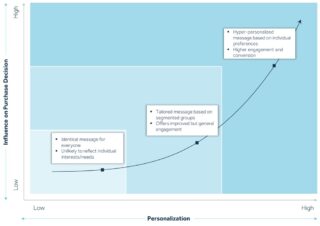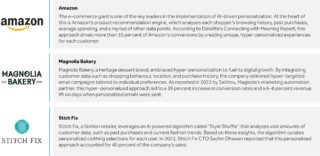
Introduction
The retail industry is undergoing rapid transformation driven by rising consumer expectations to receive tailored experiences that reflect their individual preferences, behaviors and needs across touchpoints. According to Hyken’s State of Customer Services and CX Report, 2025, 84% of customers prefer purchasing from companies that offer personalized experiences.
To stay competitive, retailers are evolving from traditional, one-size-fits-all approach to more agile and customer-centric strategies for marketing. At the core of this transformation is the use of AI to create highly personalized experiences for customers. Twilio Segment’s State of Personalization Report, 2023, highlights that 92% of the businesses are using AI-driven personalization to drive growth in their business.
With this increased emphasis on creating highly personalized customer interactions businesses leverage artificial intelligence in conjunction with real-time data to tailor their marketing for individual customers. This level of personalization is referred to as hyper-personalization.
How Does Hyper-Personalization Differ from Traditional Personalization
Businesses have been personalizing their marketing campaigns for years. While there are similarities between traditional and hyper-personalization, the differences lie in the depth of the data used and the level of personalization that’s offered.
Traditional personalization primarily relies on basic customer data, such as age, gender, location, and purchase history. Retailers leverage this data to segment audiences into broad groups and tailor their marketing campaigns accordingly. For instance, a promotional email from a fashion retailer targeting audiences aged 20-40 years in Dubai Downtown would read “Hi (Name), enjoy 15% off on your next purchase in our newly opened flagship store at Dubai Mall”. This message is based on a standard template that is shared with a group of customers.
Hyper-personalization, on the other hand, is highly sophisticated. It leverages AI, real time data, and complex parameters such as browsing history, social media activity, and wish listed products, enabling retailers to deliver one-to-one promotional messages.
For instance, a hyper-personalized campaign from the same fashion retailer would read as “Hi (Name), shop our latest sportswear collection – now with 15% off! Available at our new Dubai Mall store, right near you.” This message is personalized for an individual customer based on their recent search history for sports apparel and is delivered at a time when the customer is most likely to make a purchase.
Figure 1: Influence of Personalization on Purchase Decision

Steps for Implementing Hyper-Personalization in Retail
Implementing hyper-personalization in retail requires the integration of customer data, artificial intelligence, and data analytics to deliver a truly personalized shopping experience. The retailers achieve this through a series of interconnected steps:
1. Data Collection & Integration
- Gathering customer data from all touchpoints – online and offline. This includes browsing activity, in-store interactions, social media, and others
- Consolidating data in one place to create a unique profile for each customer
2. Real-time Analytics & Data Enrichment
- Leveraging artificial intelligence to analyze data and identify patterns & affinities for each customer
- Continuously updating/enriching customer profiles based on new interactions
3. Customer-Specific Action Planning
- Determining the next best action for each customer
- This could be selecting which product recommendation to show, which content to display, or whether to trigger an offer – all based on the customer data and insights from step 1 & 2
4. Omnichannel Personalization Delivery
- Delivering the action identified in step 3 through the appropriate channel at the right time
- This could be via the retailer’s website, email, SMS, or push notifications from the retailer’s mobile application
5. Feedback Loop & Continuous Optimization
- Improving the algorithm based on customer responses to deliver more accurate recommendations and personalized offers
- Over time, AI models become increasingly precise as they learn from each interaction
With the increased prevalence of interconnected devices such as smartphones, smartwatches, and IoT-enabled home appliances, organizations are able to gather more granular, real-time customer data to provide a better, hyper-personalized experience. When executed well, hyper-personalization can deliver up to eight times the return on investment in marketing spend and increase sales by 10% or more, as highlighted in Deloitte’s The CMO’s Guide to AI-Powered Marketing, 2023.
Key Considerations for Implementing Hyper-Personalization in Retail
To effectively deliver hyper-personalization, companies must develop a robust system that can handle large volumes of customer data, enable advanced data analytics, and uphold strict data security standards.
1. Scalable Digital Infrastructure
- Hyper-personalization relies on processing vast amounts of data from sources such as point-of-sale systems, e-commerce platforms, mobile applications, and loyalty programs. Legacy systems often struggle with the speed and volume of data required for instant personalization (e.g., real-time product recommendations, dynamic pricing).
- This underscores the need for scalable solutions, including cloud computing platforms, data lakes and warehouses, and real-time analytics engines to ensure that the personalization experience remains smooth, even during peak shopping periods.
2. Customer Data Platforms
- While there is no shortage of customer data, turning it into actionable insights remains a key challenge. According to Salesforce’s State of Marketing Report 2024, marketers today use an average of 8 different marketing tools and technologies, ranging from customer relationship management systems to transaction systems. Despite the volume of data, the lack of integration across systems often results in fragmented customer views.
- To enable true hyper-personalization, retailers require a unified, 360-degree view of each customer. In practice, this means breaking down data silos and consolidating information from all touchpoints into a single unified profile for each customer.
- A key enabler of this process is the Customer Data Platform (CDP), which allows businesses to pull in customer data from any channel, system, or data stream to build unified customer profiles and deliver personalized customer experiences.
3. Data Privacy and Compliance
- Real-time personalization is a powerful tool that enables retailers to deliver more relevant and engaging experiences for their customers. However, it is crucial to strike a balance between the use of personal data and the responsibility to protect customer privacy.
- According to the PwC Voice of the Consumer Survey 2024, 83% of consumers stated that protecting their personal data is one of the most crucial factors in earning their trust. Retailers must therefore adopt a privacy-by-design mindset when implementing hyper-personalization.
- This approach includes obtaining consent before collecting any personal information, maintaining transparency about privacy policies, offering options to opt out of data collection or delete gathered data, and implementing robust cybersecurity measures to safeguard customer information.
The above considerations form key aspects of a business’s ability to adopt and leverage hyper-personalization effectively.
Retailers Are Already Leveraging Hyper-Personalization at Scale
Globally retailers have been leveraging artificial intelligence and real-time data to tailor experiences at an individual level, ultimately providing a hyper-personalized experience to its customers. Here are the examples of few large companies that exemplify the implementation of hyper-personalization in retail:
 Each of these players uses artificial intelligence not just as a tool, but as a core strategy to continuously learn about customers and tailor experiences in real time. These case studies show tangible benefits, including higher conversion rates, increased customer engagement, and higher sales – all fueled by AI’s ability to deliver the right content or product to the right person at the right moment.
Each of these players uses artificial intelligence not just as a tool, but as a core strategy to continuously learn about customers and tailor experiences in real time. These case studies show tangible benefits, including higher conversion rates, increased customer engagement, and higher sales – all fueled by AI’s ability to deliver the right content or product to the right person at the right moment.
Next Steps for Retailers in the Age of Hyper-Personalization
The retail industry is moving away from traditional personalization methods and increasingly focusing on hyper-personalization, marked by fierce competition and a constant drive among retailers to find new ways to connect with their audience. In fact, Salesforce’s State of Marketing report states that 89% of marketers believe they must continuously innovate to remain competitive.
Looking ahead, hyper-personalization in retail will be increasingly shaped by strategic investments in predictive analytics, conversational AI, and immersive technologies such as AR and VR.
- Predictive analytics will allow retailers to move beyond reactive campaigns, enabling them to anticipate customer needs and deliver proactive, tailored experiences. According to Twilio Segment’s State of Personalization Report 2024, 86% of business leaders expect a significant shift from reactive to predictive personalization across their industry
- Conversational AI, including chatbots and voice assistants, will enable seamless, 24/7 interactions across customer touchpoints. In a 2024 survey by TIDIO, an AI chatbot service provider, 82% of the 1,015 respondents stated that they would prefer using an AI chatbot over waiting for a human agent
- Immersive technologies such as AR and VR will redefine how customers engage with products, offering interactive and context-aware shopping experiences that enhance purchase confidence and encourage purchases. As highlighted by Salesforce, 71% of respondents said they would shop more frequently if they could use AR
Retailers that adopt and integrate these advanced strategies will be positioned to build long-term customer loyalty, differentiate their brands, and achieve sustainable growth in an increasingly dynamic and competitive retail environment.
References:
- Hyken State of Customer Services and CX Report (2025)
- Salesforce 9th Edition State of Marketing Report (2024)
- PwC Voice of the Consumer Survey (2024)
- Deloitte CMO’s guide to AI-powered marketing (2024)
- TIDIO The Future of Chatbots Survey (2024)
- Salesforce Augmented Reality in Ecommerce (2024)
- Twilio Segment State of Personalization Report (2023 and 2024)
- Sailthru How Magnolia Bakery Increased Sales with Better Customer Data Report (2023)
- Deloitte Connecting with Meaning Report (2020)
- Reso Analysis




